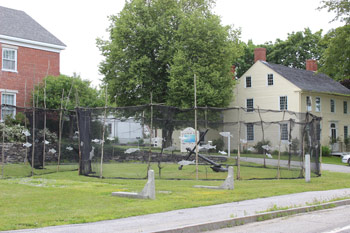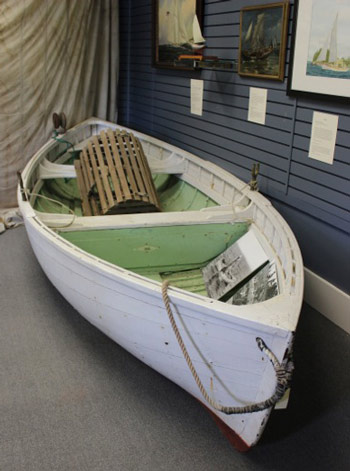Data Yields Trajectory of Maine’s Coastal Fisheries at PMM
by Mike Crowe

Weir exhibit on the front lawn at the Penobscot Marine Museum in Searsport, Maine. Through the summer and into October the museum is featuring a series of exhibits and events on the history of commercial fishing. Fishermen’s Voice photo
As part of a series of talks, workshops and events on commercial fishing in Maine over the summer, Bill Leavenworth presented "Maine Coastal Fisheries,” on July 6, at the Penobscot Marine Museum in Searsport. Leavenworth researched two centuries of fishing logs. The logs gave daily accounts of wind, weather, fish caught by each man and peripheral observers. Logs referenced were from Frenchmen's Bay, the National Archives, the Essex Institute in Salem, MA and the Smithsonian Archives in Washing ton, DC. The earliest log was from the second decade of the 19th century.
Leavenworth's research from the earliest colonial records revealed an almost immediate impact on some groundfish stocks in the Boston area. But the Maine coastal ground fisheries had remained highly productive until the 1920s, when the impacts of multiple stresses began to take their toll on the resource. Technological developments have had the greatest negative impacts on Gulf of Maine stocks, said Levenworth.
The Isles of Shoals cod stocks were supported by the enormous estuarine ecosystem between Cape Ann, MA and Cape Elizabeth, ME. The estuarine ecosystem ran from the Merrimack, River through the Piscataqua, River, the little streams into the Saco River and then the Scarborough Marsh system. When Massachusetts Bay Colony merchants ran short of fish, they discovered that their grant ran all the way to Casco Bay and they seized the NH and Southern Maine grants at gunpoint.
Trillions of spawn from anadromous fish such as alewives, blue back herring, American shad, salmon, elvers, shortnose and Atlantic sturgeon, rainbow smelt, and sea lamprey poured out of streams and rivers into estuaries and the Gulf of Maine, becoming prey fish for other fish like cod and haddock.
There was constant friction between dam owners and the general population, and the Massachusetts Bay colony passed a law around 1749 requiring dam owners to open their flash boards and permit the passage of alewives, which were then essential sources of protein, cattle feed, and fertilizer to inland communities. Newspapers in the later 18th and early 19th century regularly reported on these contentions and laws.

Late19th to early 20th century traditional Maine peapod, part of the commercial fishing exhibit at the museum. Fishermen’s Voice photo
At the time, all commercial fishing was done with handlining, a single line with a single hook, which didn't stress the bait supply. But in 1868, with the introduction of tub trawls, a single fisherman used hundreds of hooks on a single long line. The bait supply was impacted and shortages followed. In response to the shortage another technology was introduced, the gill net. The Fish Commission at the time advocated for this bait saving net. It used no bait, but killed everything that swam into it, including pre-spawning cod. Within 10 years, cod disappeared from Ipswich, Massachusetts, sad Levenworth.
Menhaden was a plentiful fish, the base of the food chain pyramid and essential to healthy cod stocks. Menhaden is an oily fish. As the industrial revolution got underway in the middle of the 1800s oil was needed for machinery. Petroleum products were not yet available. Whale oil had been used as a lubricant and for lamp oil. Menhaden was caught in large quantities and pressed for its oil.
In 1878, 20 steamers from Rhode Island fished menhaden in Belfast Bay. Maine fishermen tried to prevent the steamers from coming into Penobscot Bay and depleting the menhaden resource. In 1892 they succeeded in checking the steamers, but by then menhaden had been wiped out, said Levenworth.
In the 19th century, there were 1,000 fish weirs on the Maine coast where salmon, shad, alewives and herring were caught. In 1902, 152,812,766 pounds of Atlantic herring were caught in weirs. Also caught inshore were smelts, salmon, silver hake and sand lance. The weir catch total, said Levenworth, was usually more than 50% of the total catch.
But it was the introduction of mobile gear—the otter trawl, hauled by boats powered by engines—that made the biggest single impact, said Leavenworth. They caught more of everything and everything began to decline. The increasing use of nets meant more kinds of fish were caught, but it decreased the amount of forage fish available.
 Bill Levenworth said the number of salmon taken and the fluctuations in the number suggest spawning salmon were getting past dams on the Penobscot River during this period a time when many year round dams were in place. Levenworth presented data from several sources including the federal fish commission.
Bill Levenworth said the number of salmon taken and the fluctuations in the number suggest spawning salmon were getting past dams on the Penobscot River during this period a time when many year round dams were in place. Levenworth presented data from several sources including the federal fish commission.
More of this data can be seen here on our site.
Dam building began with water wheels for mechanical power grind grain, to power belt-driven machines then seasonal electricity for mills and finally by the 1880's full time power generation for mills.
Along with this industrial development came runoff from Maine's apple farms that used substantial quantities of copper arsenic. Portland was thr third largest apple exporter to Europe. Added to this was waste from coal tar dyes used in factories and the byproducts of coal gas production burned in city street lights, both toxic to fish. All of these impacted the food web fish depended on. Leavenworth thinks removing dams is a good thing, but fish passages around dams had been required in many places early on. Leavenworth thinks the dramatic stock declines in fish stocks are aligned with the introduction of trawlers.
Leavenworth said the harvest today in Penobscot Bay is 2% of what it was in the last part of the 19th century. Single hook fishing would restore it, he said. In 2017 dollars, Penobscot Bay fisheries in the late 19th century were worth $10 million annually.
